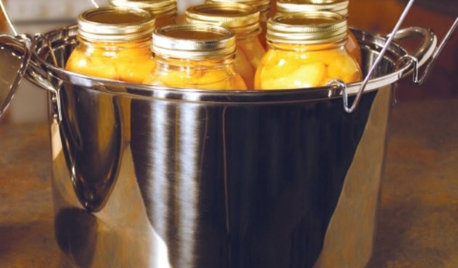Pressure canning -- did I do it right?
julsie
17 years ago
Related Stories

DISASTER PREP & RECOVERYRemodeling After Water Damage: Tips From a Homeowner Who Did It
Learn the crucial steps and coping mechanisms that can help when flooding strikes your home
Full Story
BATHROOM MAKEOVERSFrom Canning Porch to Beautiful Vintage Bath in Oregon
Thrifty finds and DIY labor transform a cramped space into a serene hotel-style bath on a budget
Full Story
EDIBLE GARDENSHouzz Call: What Did You Grow This Summer?
Let’s celebrate the homegrown fruits and vegetables of the season. Post your pictures and tell us about your harvest
Full Story
PRODUCT PICKSGuest Picks: Canning, Preserving, Steaming, Dehydrating
20 products to help make fall produce last through the season and beyond
Full Story
GARDENING AND LANDSCAPINGDesign Eye on the Oscars: The Kids Are All Right
And the Winner Is ... That Amazing Terraced Garden
Full Story
BEDROOMSThe Right Mattress: The Secret to a Great Night’s Sleep
We spend a third of our lives asleep, so investing in a quality mattress is essential. Check out this expert advice to help you choose yours
Full Story
BATHROOM DESIGN3 Fresh and Fun Bathrooms Just Right for Teenage Girls
These new and remodeled spaces designed for pairs of sisters are brimming with personality and style
Full Story
BATHROOM DESIGNHow to Choose the Right Bathroom Sink
Learn the differences among eight styles of bathroom sinks, and find the perfect one for your space
Full Story
EVENTSMy Houzz: They’re Right at Home in Their Schindler House
Chance brought a couple to their Inglewood home designed by the L.A. midcentury architect. It will be part of a June design tour
Full StoryMore Discussions







readinglady
julsieOriginal Author
Related Professionals
East Rancho Dominguez Landscape Architects & Landscape Designers · Owings Mills Landscape Architects & Landscape Designers · Richmond Heights Landscape Architects & Landscape Designers · Berkley Landscape Contractors · Fort Myers Landscape Contractors · Laguna Hills Landscape Contractors · Pleasant Prairie Landscape Contractors · Rancho Santa Margarita Landscape Contractors · Salem Landscape Contractors · Suitland Landscape Contractors · View Park-Windsor Hills Landscape Contractors · Boone Roofing & Gutters · Franklin Roofing & Gutters · Eustis Driveway Installation & Maintenance · San Jose Driveway Installation & Maintenancereadinglady
readinglady
julsieOriginal Author
readinglady
annie1992
morz8 - Washington Coast
readinglady
julsieOriginal Author
melva02
julsieOriginal Author
melva02
Linda_Lou
ernie_tn
gran2
julsieOriginal Author